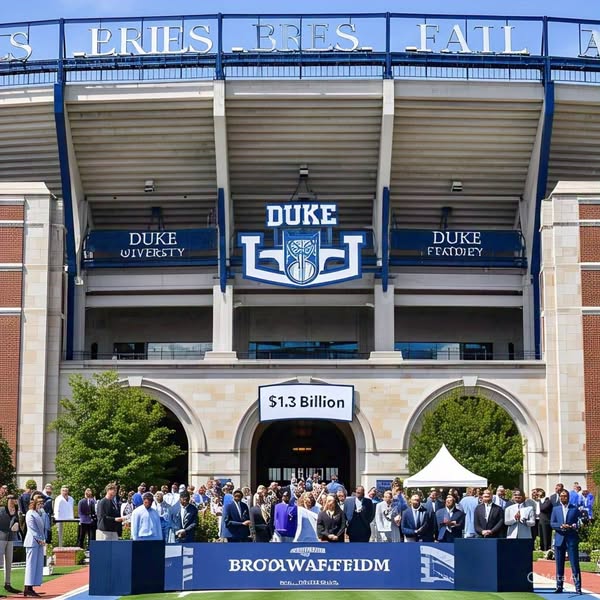In a landmark announcement that has sent shockwaves through the collegiate sports world, Duke University unveiled a monumental $1.3 billion renovation project for Brooks Field at Wallace Wade Stadium, setting a new gold standard for college basketball facilities nationwide. This unprecedented investment not only promises to transform the fan and player experience but also signals Duke’s unwavering commitment to maintaining its dominance in college athletics, especially basketball—a sport synonymous with the Blue Devils’ legacy.
Duke University, long celebrated for its basketball prowess under legendary coach Mike Krzyzewski and now carrying the torch with rising stars, has taken a bold leap forward by reimagining Brooks Field, a key part of the Wallace Wade athletic complex. While the stadium has been traditionally known as the home of Duke football, this renovation project intriguingly focuses on redefining the basketball facilities integrated within the complex, symbolizing the university’s innovative approach to blending multiple sports environments to benefit student-athletes and fans alike.
This renovation isn’t just a facelift; it represents a comprehensive overhaul of infrastructure, technology, and fan engagement capabilities designed to elevate the program to heights previously thought impossible. The project, slated for completion within the next three years, includes state-of-the-art practice facilities, expanded seating capacity, enhanced luxury amenities, cutting-edge sports science centers, and an integrated media hub, creating a dynamic environment that supports athlete development and fan interaction.
At the core of this ambitious initiative is the university’s drive to create a holistic sports ecosystem. The renovation promises to fuse the intensity of college basketball with the historic aura of Wallace Wade Stadium, fostering a unique synergy between the football and basketball programs. This fusion reflects Duke’s vision of a unified athletic campus that nurtures excellence, tradition, and community spirit.
The centerpiece of the renovation is a brand-new basketball arena nestled within Brooks Field, designed with a seating capacity of approximately 12,500—balancing intimacy with electrifying atmosphere. This arena will feature cutting-edge acoustics, HD video boards, and immersive lighting technology that transforms game nights into unforgettable experiences for fans. The design also incorporates flexible seating arrangements to accommodate various events, from NCAA tournaments to high-profile concerts and community engagements, making it a versatile asset for the university and Durham.
Beyond the fan experience, the project heavily emphasizes athlete development through cutting-edge training and recovery facilities. These include a fully equipped sports science lab with advanced analytics capabilities, biomechanical testing centers, and personalized rehabilitation spaces. By integrating data-driven performance optimization, Duke aims to give its basketball players a competitive edge, blending tradition with technology in a way that few programs can rival.
One of the most exciting facets of the renovation is the creation of a “basketball innovation hub” within the complex. This hub will serve as a collaboration space for coaches, analysts, sports scientists, and athletes to study game footage, analyze opponent tendencies, and develop winning strategies. Equipped with AI-powered tools and virtual reality technology, this center promises to revolutionize how basketball strategy and preparation are approached at the collegiate level.
The renovation also underscores Duke’s commitment to sustainability and community engagement. The facility will incorporate eco-friendly building materials, solar power installations, and water conservation systems, aligning with the university’s broader environmental goals. Additionally, the complex will feature public spaces accessible to Durham residents, including fitness centers, meeting rooms, and youth basketball clinics, fostering a stronger bond between the university and its surrounding community.
Financially, the $1.3 billion investment marks one of the largest single-project expenditures in college sports history. Funding for the project comes from a combination of private donations, corporate sponsorships, and university resources, reflecting broad support from alumni, donors, and partners who recognize the value of positioning Duke at the forefront of collegiate athletics innovation. Notably, the university has secured a series of long-term naming rights deals and strategic partnerships that promise to sustain the facility’s operations well into the future.
The announcement has been met with overwhelming enthusiasm from all corners of the basketball world. Duke’s head basketball coach lauded the project as a “game-changer” that will provide his team with unparalleled resources to compete at the highest levels. Current players have expressed excitement about training and competing in such a world-class environment, emphasizing the boost it will provide in recruiting elite talent eager to join a program with such cutting-edge support.
Sports analysts are already predicting that this renovation will reshape the landscape of college basketball facilities across the country. Many expect other top-tier programs to follow Duke’s lead, recognizing that future success will increasingly depend on investments in infrastructure that combine tradition with modern innovation. The project also highlights the escalating competition among universities not just on the court but in the arms race of facilities and athlete support services.
From a cultural standpoint, this renovation reflects Duke’s deep-rooted basketball heritage while signaling a forward-thinking approach. Wallace Wade Stadium, named after one of Duke’s most iconic figures in football, has historically been a symbol of tradition and pride. By weaving the basketball program’s future into this storied complex, Duke is sending a powerful message: the past and future of Duke athletics are inextricably linked, and the Blue Devils are poised to continue their legacy of excellence for generations to come.
The timing of the announcement also coincides with a pivotal moment in college sports, as universities grapple with evolving NCAA regulations, the impact of Name, Image, and Likeness (NIL) policies, and shifting recruitment dynamics. By investing so heavily in its facilities, Duke is positioning itself not just to adapt but to lead in this new era. The state-of-the-art amenities and technology embedded in the renovation are designed to support athletes in maximizing their potential both on and off the court, including media training, branding opportunities, and academic support services.
Fans, meanwhile, can look forward to an entirely new game-day experience. The renovation will introduce expanded premium seating options, including luxury suites, club lounges, and social gathering areas that cater to the diverse preferences of Duke’s passionate fan base. Enhanced food and beverage offerings, seamless mobile ticketing, and upgraded parking facilities will all contribute to making Brooks Field a must-visit destination for sports enthusiasts.
Moreover, the project anticipates leveraging cutting-edge connectivity technologies such as 5G and augmented reality (AR) to bring fans closer to the action. Imagine AR overlays on your mobile device providing real-time stats, player biometrics, and immersive storytelling throughout the game—a feature that promises to revolutionize the way fans engage with college basketball.
Community leaders and Durham residents have expressed cautious optimism about the project’s potential impact on the local economy and neighborhood character. University officials have emphasized their commitment to responsible development, including plans for improved transportation infrastructure and initiatives to ensure the surrounding area benefits from increased visitation and economic activity.
As groundbreaking is expected to commence in the coming months, the university has set ambitious goals for the completion timeline, aiming to open the renovated Brooks Field ahead of the 2028 basketball season. This timeline aligns with the NCAA’s upcoming tournament cycles and other major collegiate sporting events, ensuring Duke is well-positioned to host marquee competitions and enhance its national profile.
In summary, Duke University’s $1.3 billion renovation of Brooks Field at Wallace Wade Stadium represents more than just a construction project—it is a bold declaration of the university’s vision for the future of college basketball. By combining architectural innovation, athlete-centered design, cutting-edge technology, and a commitment to sustainability and community, Duke is setting a new benchmark for what college athletic programs can achieve.
This project promises to redefine the fan experience, revolutionize athlete development, and solidify Duke’s position as a leader in collegiate sports for decades to come. The reverberations of this announcement will be felt across the college basketball landscape, inspiring other programs to rethink their own facilities and strategies as the competition for athletic excellence intensifies.
For the Blue Devils, this is not just about building a stadium—it is about building a legacy that honors the past, celebrates the present, and boldly embraces the future. The unveiling of this renovation is a historic moment for Duke University, its athletes, its fans, and the entire college basketball community, marking the dawn of a new era in the sport that has captivated millions around the world.



